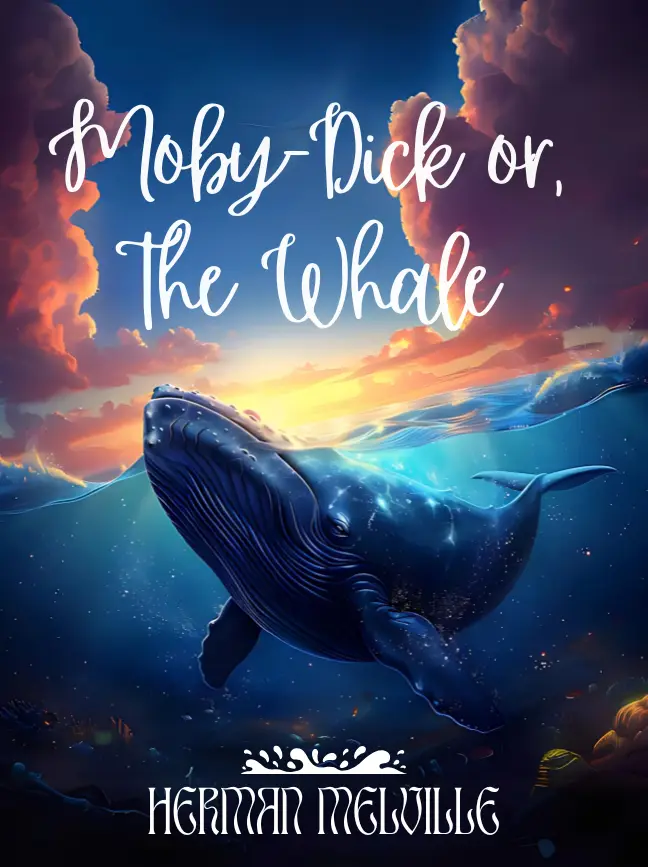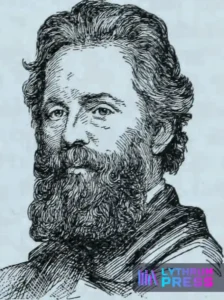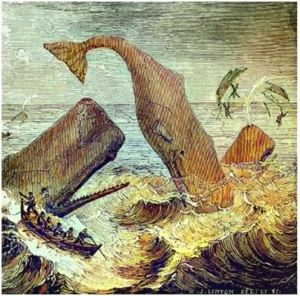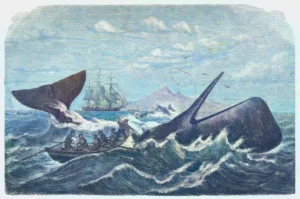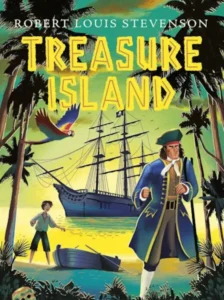“It is the horrible texture of a fabric that should be woven of ships’ cables and hawsers. A Polar wind blows through it, and birds of prey hover over it.”
So Melville wrote of his masterpiece, one of the greatest works of imagination in literary history. In part, Moby-Dick is the story of an eerily compelling madman pursuing an unholy war against a creature as vast and dangerous and unknowable as the sea itself. But more than just a novel of adventure, more than an encyclopaedia of whaling lore and legend, the book can be seen as part of its author’s lifelong meditation on America. Written with wonderfully redemptive humour, Moby-Dick is also a profound inquiry into character, faith, and the nature of perception.
This edition of Moby-Dick, which reproduces the definitive text of the novel, includes invaluable explanatory notes, along with maps, illustrations, and a glossary of nautical terms.
Who Wrote Moby-Dick
Moby-Dick was written by Herman Melville. The novel was first published in 1851 and is considered one of the greatest works of American literature. It tells the story of Captain Ahab‘s obsessive quest to hunt the white whale, Moby Dick, as narrated by a sailor named Ishmael.
Why is Moby-dick Famous
Moby-Dick is famous for several reasons, making it a cornerstone of American literature:
- Exploration of Universal Themes: The novel delves into profound themes such as obsession, revenge, the struggle against nature, and humanity’s place in the universe. Captain Ahab’s relentless pursuit of the white whale symbolizes the destructive potential of unchecked ambition and obsession.
- Complex Symbolism: The white whale, Moby Dick, represents different things to different characters and readers—nature’s power, the unknown, and even existential struggle. This rich symbolism adds layers of interpretation to the novel.
- Innovative Narrative Style: The book blends adventure, philosophical reflection, and detailed accounts of whaling, creating a narrative that is both thrilling and intellectually challenging. Its mix of genres and unconventional structure was groundbreaking at the time.
- Larger-than-Life Characters: Characters like Captain Ahab and Ishmael have become iconic in literature. Ahab’s obsessive and tragic character has inspired countless interpretations and adaptations.
- Historical and Cultural Insight: The novel provides an in-depth look at the 19th-century whaling industry, offering a vivid depiction of life at sea and the economic and social factors of the time.
- Legacy and Influence: Initially a commercial failure, the book gained recognition in the 20th century for its literary genius. Today, it’s a staple in literary studies and has influenced countless writers, artists, and filmmakers.
These elements have secured Moby-Dick‘s status as a masterpiece, celebrated for its depth, complexity, and enduring relevance.
What is Moby-dick About
Moby-Dick is a novel that tells the epic tale of Captain Ahab, the obsessive captain of the whaling ship Pequod, and his relentless pursuit of a giant white whale named Moby Dick. The story is narrated by Ishmael, a sailor who joins the Pequod on its voyage.
Plot Overview:
- Ishmael’s Journey: The story begins with Ishmael deciding to go to sea for adventure. He befriends Queequeg, a tattooed harpooner, and they join the crew of the Pequod.
- Captain Ahab’s Obsession: Captain Ahab, who lost his leg to Moby Dick on a previous voyage, is consumed by a personal vendetta against the whale. He vows to hunt and kill it, prioritizing his revenge over the safety of his crew.
- The Pursuit: The Pequod sails across the world’s oceans, encountering other ships and hearing stories about Moby Dick. Ahab’s obsession grows, and he drives the crew into dangerous situations in his quest to find the whale.
- Themes of Fate and Free Will: As the journey unfolds, the novel explores deep philosophical questions about fate, free will, and humanity’s place in the universe.
- The Climax: The hunt for Moby Dick culminates in a dramatic and tragic confrontation. Ahab finally encounters the whale, but the battle leads to his downfall and the destruction of the Pequod.
- Ishmael’s Survival: Ishmael is the sole survivor, clinging to a coffin-turned-lifeboat until he is rescued.
Key Themes:
- Obsession and Revenge: Ahab’s fixation on Moby Dick represents the dangers of allowing a single purpose to consume one’s life.
- Man vs. Nature: The novel portrays humanity’s struggle against the uncontrollable forces of nature.
- The Unknown: Moby Dick, as a mysterious and enigmatic force, symbolizes the vastness and uncertainty of life.
Moby-Dick is much more than a whaling adventure—it’s a profound exploration of human nature, morality, and the universe’s mysteries.
What kind of Whale was Moby-dick
Moby Dick is described as a sperm whale (Physeter macrocephalus). Sperm whales are the largest toothed whales and are known for their massive heads, distinctive square-shaped foreheads, and ability to dive to great depths in search of squid, their primary prey.
Characteristics of Moby Dick in the Novel:
- Size: Moby Dick is depicted as unusually large, even for a sperm whale, making him an extraordinary and intimidating creature.
- Color: The whale is primarily white, which contributes to his haunting and almost supernatural presence in the story.
- Behavior: Unlike typical sperm whales, Moby Dick is aggressive and vengeful. He has a reputation for attacking whaling ships and is considered nearly indestructible.
- Scars: The whale is marked with numerous scars from past encounters with whalers, adding to his mystique as a symbol of nature’s power and resilience.
Sperm whales, like Moby Dick, were a central focus of the 19th-century whaling industry, making them a fitting choice for Melville’s exploration of humanity’s struggle against nature.
How Many Pages is Moby-Dick – How Long is Moby-dick
The length of Moby-Dick can vary depending on the edition, formatting, and publisher. However, here are some general estimates:
- Original Publication (1851): About 635 pages.
- Modern Print Editions: Typically range from 550 to 750 pages, depending on the font size, page dimensions, and inclusion of supplementary materials like introductions or notes.
Word Count:
The novel contains approximately 212,000 words, making it a lengthy and dense read.
Reading Time:
- For an average reader, it may take 15 to 20 hours to finish, depending on reading speed and familiarity with 19th-century prose.
- Its complexity, philosophical passages, and detailed descriptions can make it a challenging but rewarding experience.
If you’re considering reading it, many modern editions include annotations or summaries that help navigate the more intricate sections.
When Was Moby-Dick Written
Moby-Dick was written by Herman Melville between 1849 and 1851. It was first published in:
- October 1851 in London under the title “The Whale”.
- November 1851 in New York as “Moby-Dick; or, The Whale”.
The novel was inspired by Melville’s experiences as a sailor on whaling ships and by real-life events, such as the sinking of the whaling ship Essex by a sperm whale and the legend of a notorious white whale named Mocha Dick.


